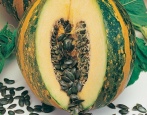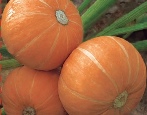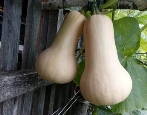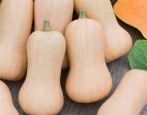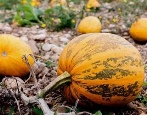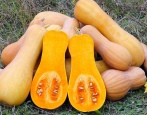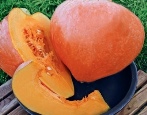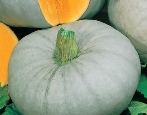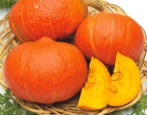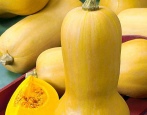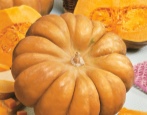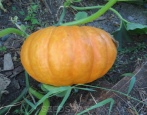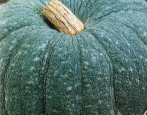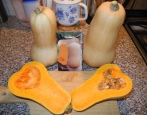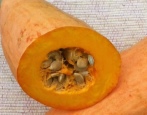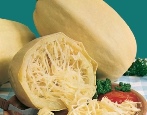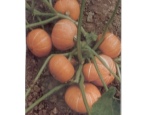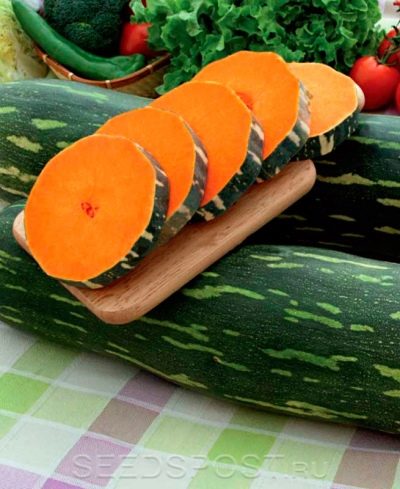
- The form: cylindrical
- Weight, kg: 18-20
- Coloration: yellow-orange streaks on a gray-green background
- Bark: thin
- Color of the pulp: bright orange
- Pulp (consistency): dense, fibrous
- Taste: sweet
- Seed nest: small
- Growing regions: all regions of Russia
- Disease and pest resistance: stable
Those housewives who love to cook various pumpkin dishes are always looking for new products. Exotic varieties are in high demand. These include a mid-season pumpkin variety with the unusual name Lunga di Napoli of Italian selection.
Description of the variety
Bred by a group of Italian breeders, the Lunga di Napoli pumpkin is a powerful plant. A strong pumpkin bush of an indeterminate type is characterized by thickened stems that can curl and crawl on the ground, moderate thickening with large fine-toothed leaves of a uniform rich green color, which are attached to the stem by means of thick petioles, as well as a developed root system.
During flowering, unisexual flowers of an unusual color are formed on the bushes - saffron yellow. Ovaries are formed mainly on female flowers. The plant is pollinated by insects. On one bush, 2-3 large pumpkin specimens are formed and grow.
Characteristics of the appearance of plants and fruits
The giant pumpkin stands out among its congeners with its unusual shape and parameters. Vegetable weight can vary from 18-20 to 30-35 kg. The length of the fruit can reach 60-100 cm. The shape of the pumpkin is cylindrical or pear-shaped. The bark of the vegetable is smooth, hard, with dullness, has an unusual color - a gray-green background is diluted with yellow-orange veins and blotches. The seed chambers are located compactly, containing a small amount of seeds.
Cut pumpkins lend themselves to transportation, and can also be stored for a long time without loss of taste and useful properties. The specimens neatly cut with secateurs have the maximum keeping quality.
Purpose and taste
Lunga di Napoli is characterized by excellent taste. The flesh of vegetables is medium-dense, tender, slightly friable, fleshy and juicy. Light fiber may be present in some specimens. The taste is dominated by pleasant sweetness, complemented by a pronounced nutmeg aroma. It is important that the bright aroma and delicious taste remain even after heat treatment. It is also worth noting that the pulp contains an increased amount of trace elements, vitamins, sugars.
The harvested crop can be used for making salads, mashed soups, pie fillings, as well as preparing cereals, casseroles, jams, juices. In addition, the variety is suitable for baby and dietetic food, due to its low calorie content.
Ripening terms
Pumpkin belongs to the category of mid-season varieties. From mass germination to absolute maturity of fruits in the beds, 120 days pass. Sometimes (depending on climatic conditions) it takes 130 days for technical maturity. It is recommended to cut specimens in September.
Yield
High productivity is one of the advantages of this variety. On average, 2-3 large fruits weighing 15-35 kg can be obtained from one bush.
Growing regions
This pumpkin variety is most productive when grown in the Central region, as well as in the southern part of the country. Recently, the geography of growth has expanded to the scale of the entire country.
Growing and care
The vegetable is cultivated both by seed and seedlings. Seeds are sown for seedlings at the end of April. For this, a nutrient substrate and individual containers (peat or disposable cups) are prepared in advance.The seeds are sorted, disinfected, and also, if desired, germinated to accelerate the emergence of sprouts. The transplant of mature bushes with 2-4 leaves is carried out in 25-30 days. When carrying out the procedure, it is important that the air and soil are sufficiently warmed up.
Sowing seeds in open ground is carried out in the first decade of May. For this, holes are prepared, where seeds are sown to a depth of 3-6 cm. If there is a possibility of recurrent spring frosts, then cover with a film will be needed. The optimal scheme for sowing is 100x100 cm.
Plant care consists of standard procedures: watering around the stem as the soil dries up, applying organic and mineral fertilizers 3-4 times per season, loosening the soil after each watering, weeding row spacings, forming a bush in 1-2 stems, removing other shoots, prevention infections and pest attacks.
Requirements for soil and climatic conditions
Pumpkin Lunga di Napoli has good stress resistance, thanks to which the culture easily survives temperature changes, light shade and heat. The vegetable is susceptible only to prolonged drought. For cultivation, a sunny place is chosen, abundantly illuminated throughout the day, where there is a barrier from drafts. The vegetable prefers soil light, loose, fertile, air and moisture permeable. In addition, the acidity level should be taken into account - the soil should not be acidic and heavy.
Disease and pest resistance
The immunity of the variety is good, therefore, with proper care, the culture is rarely exposed to fungal diseases.
